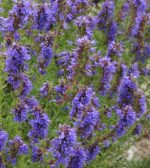
Hyssop is a small semi-evergreen subshrub up to 24″ tall native to southern Europe, the Middle East, and the area around the Caspian sea but has naturalized in parts of the US. It is a member of the deadnettle family, Laminaceae, that also includes mint, basil, and beebalm. Plants have a woody base and a number of many branched upright square stems carrying shinny, dark green, lanceolate leaves that are toothed, stalkless, aromatic and up to 1″ long. The 2-lipped, tubular, fragrant flowers are blue to violet and have protruding stamens. They appear in whorls on terminal spikes from mid- to late summer and are attractive to bees, butterflies and hummingbirds. For centuries hyssop has been used as a medicinal, culinary and ornamental herb, and its volatile oil is used in some liqueurs including Benedictine and Chartreuse. Hyssop is an attractive plant for a border, a knotgarden, herb, butterfly, bird, or rock garden. The genus name, Hyssoppus, is the classical name for this herb adapted from the Semitic plant name, ezob. The specific epithet, officinalis, is the Latin word meaning belonging to an officina, the storeroom of a monastery, where medicines and other necessaries were kept, and refers to the medicinal use of the plant.
Type: Herbaceous perennial
Bloom:Two-lipped, tubular, fragrant, blue to violet flowers with protruding stamens appear in whorls on terminal spikes from mid- to late summer
Size: 1.5-2′ H x 1-1.5′ W
Light: Full sun with afternoon shade in the South
Soil: Average to poor, moderately moist to dry, well-drained; thrives with moderate moisture but is drought tolerant.
Hardiness: Zones 4-9
Care: Cut back in early to mid spring.
Pests and Diseases: None of significance
Propagation: Division, cuttings, seed (plants selfseed)
Companion Plants: Rosemary, sage, lavender
Photo Credit: Wikimedia